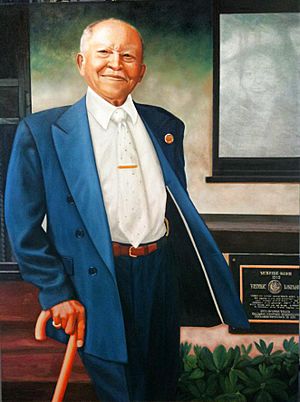Ernest McBride Sr. facts for kids
Ernest Samuel McBride Sr. (born November 20, 1909 – died May 5, 2007) was an important African American leader. He worked for civil rights and helped workers in Long Beach, California. He fought to make things better for African Americans. This included getting them better jobs, fair housing, and equal treatment in places like the police and fire departments.
McBride helped start the Long Beach chapter of the National Association for the Advancement of Colored People (NAACP). The NAACP is a group that works for equal rights for all people. Like Martin Luther King Jr., McBride believed in peaceful protest. He followed the ideas of Mahatma Gandhi, who taught people to make changes without violence. Because of his work, McBride was watched by the FBI as part of a program called COINTELPRO. This program watched many civil rights leaders, including Martin Luther King Jr. Today, McBride's important work is remembered. Many awards honor him, his home is a historic landmark, and a high school and park are named after him.
Early Life and Learning
Ernest McBride was born on November 20, 1909. He was one of seven children in a farming family in Mississippi. At that time, there were no schools for black children in Mississippi. So, when Ernest was 8, his family moved to Arkansas. This way, the children could go to school.
In Little Rock, Arkansas, Ernest and his brothers and sisters went to schools that were separated by race. This meant black children and white children went to different schools. While he was still in school, he saw a terrible act of violence against a black man. This experience showed him how much change was needed. At his all-black school, Scipio A. Jones High School, McBride learned about Mahatma Gandhi. He learned how Gandhi used peaceful ways to fight unfairness. McBride finished high school in 1930.
Working for Change
After school, McBride played baseball for a short time with the Memphis Red Sox. This team was part of the Negro National League. But soon, he went to California. He was looking for better jobs and higher pay.
When he arrived in Long Beach in 1930, he found that the city was also segregated. His first job was loading cotton onto ships in San Pedro Harbor. He found out that his all-black crew was paid less than the workers before them. Those workers, who were Latino, had been fired for asking for more money. McBride quit his job to fight for workers' rights. He wanted all shipyard workers to be able to join a union, no matter their race.
In 1932, while working at a Ralph's grocery store, McBride became a union organizer. He helped the Ralph's employees form a union. They protested outside the store until the store agreed to work with the union.
McBride worked on a committee for the Congress of Industrial Organizations (CIO) for five years. He could speak for any government worker west of the Mississippi River. He worked hard to help black people get jobs in Long Beach. This included jobs in the city's trash, police, and fire departments.
In 1940, McBride and his wife, Lillian, decided to start a Long Beach chapter of the NAACP. They met with friends like Roscoe Hayes, L.J. Jones, and Nathan Holly. They held their first meetings at the McBrides' home. The police watched them closely. With help from Reverend Willy Lomax of the Second Baptist Church, they raised enough money and got enough members. Soon, they became an official NAACP chapter.
McBride fought against many unfair rules. In 1948, he and his wife tried to buy a home on Lemon Avenue in Long Beach. White neighbors tried to stop them with special rules and a petition. But McBride kept going. He bought the house and raised his six children there. Their home became a regular meeting place for civil rights activists. In the 1950s, the McBrides hosted important African American leaders. These included Eslande Goode Robeson, wife of Paul Robeson, and Margarita Belafonte, wife of Harry Belafonte. In 1994, the Long Beach City Council made the McBride home a historical landmark.
McBride became a local hero. He helped start the Long Beach NAACP. He successfully fought to end segregation in many places. This included the Long Beach Police Department, the Long Beach Fire Dept., Ralph's grocery stores, the naval shipyard, and General Telephone Co. He even helped students protest to stop local officials from putting on blackface minstrel shows.
From 1948 to 1972, the U.S. Federal Bureau of Investigation (FBI) watched McBride. The FBI was worried that civil rights leaders might have ties to communism. So, they watched and sometimes worked against civil rights groups and leaders. This was part of their COINTELPRO program.
Remembering Ernest McBride
Ernest McBride Sr. passed away in 2007. He was 97 years old.
His home is a historical landmark. Also, Long Beach has named several places in his honor. These include the Ernest S. McBride Sr. High School, Ernest McBride Skate Park, and the Ernest McBride community center.
In 2008, a book about his life was released. It is called Fighting for the People. It was written with Sunny Nash.


